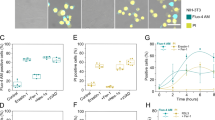Abstract
In monolayer of HeLa cells treated with tumor necrosis factor (TNF), apoptotic cells formed clusters indicating possible transmission of apoptotic signal via the culture media. To investigate this phenomenon, a simple method of enabling two cell cultures to interact has been employed. Two coverslips were placed side by side in a Petri dish, one coverslip covered with apoptogen-treated cells (the inducer) and another with non-treated cells (the recipient). TNF, staurosporine, or H2O2 treatment of the inducer cells is shown to initiate apoptosis on the recipient coverslip. This effect is increased by a catalase inhibitor aminotriazole and is arrested by addition of catalase or by pre-treatment of either the inducer or the recipient cells with nanomolar concentrations of mitochondria-targeted cationic antioxidant MitoQ (10-(6′-ubiquinolyl)decyltriphenylphosphonium), which specifically arrests H2O2-induced apoptosis. The action of MitoQ is abolished by an uncoupler preventing accumulation of MitoQ in mitochondria. It is concluded that reactive oxygen species (ROS) produced by mitochondria in the apoptotic cells initiate the release of H2O2 from these cells. The H2O2 released is employed as a long-distance cell suicide messenger. In processing of such a signal by the recipient cells, mitochondrial ROS production is also involved. It is suggested that the described phenomenon may be involved in expansion of the apoptotic region around a damaged part of the tissue during heart attack or stroke as well as in “organoptosis”, i.e. disappearance of organs during ontogenesis.
Similar content being viewed by others
Abbreviations
- FCCP:
-
carbonyl cyanide p-(trifluoromethoxy)phenylhydrazone
- MitoQ:
-
10-(6′-ubiquinolyl)decyltriphenylphosphonium
- ROS:
-
reactive oxygen species
- TNF:
-
tumor necrosis factor
References
Skulachev, V. P. (1996) Quart. Rev. Biophys., 29, 169–202.
Droge, W. (2001) Physiol. Rev., 82, 47–95.
Skulachev, V. P. (2003) in Topics in Current Genetics. Model Systems in Ageing (Nystrom, T., and Osiewacz, H. D. eds.) Vol. 3, Springer Verlag, Berlin-Heidelberg, pp. 191–238.
Skulachev, V. P. (1997) Biosci. Rep., 17, 347–366.
Skulachev, V. P. (1998) Biochemistry (Moscow), 63, 1438–1440.
Pletjushkina, O. Y., Fetisova, E. K., Lyamzaev, K. G., Ivanova, O. Y., Domnina, L. V., Vyssokikh, M. Y., Pustovidko, A. V., Vasiliev, J. M., Murphy, M. P., Chernyak, B. V., and Skulachev, V. P. (2005) Cell Death Differ., 3, 1–3.
Shchepina, L. A., Pletjushkina, O. Yu., Avetisyan, A. V., Bakeeva, L. E., Fetisova, E. K., Izyumov, D. S., Saprunova, V. B., Vyssokikh, M. Yu., Chernyak, B. V., and Skulachev, V. P. (2002) Oncogene, 21, 8149–8157.
Touraine, R. L., Vahanian, N., Ramsey, W. J., and Blaese, R. M. (1998) Hum. Gene Ther., 9, 2385–2391.
Azzam, E. I., Toledo, S. M., and Little, J. B. (2001) Proc. Natl. Acad. Sci. USA, 98, 473–478.
Murphy, M. P. (2001) Expert Opin. Biol. Ther., 1, 753–763.
Kelso, G. F., Porteous, C. M., Hughes, G., Ledgerwood, E. C., Gane, A. M., Smith, R. A., and Murphy, M. P. (2002) Ann. N. Y. Acad. Sci., 959, 263–274.
Liberman, E. A., Topali, V. P., Tsofina, L. M., Jasaitis, A. A., and Skulachev, V. P. (1969) Nature, 222, 1076–1078.
Grinius, L. L., Jasaitis, A. A., Kadziauskas, J. P., Liberman, E. A., Skulachev, V. P., Topali, V. P., and Vladimirova, M. A. (1970) Biochim. Biophys. Acta, 216, 1–12.
Liberman, E. A., and Skulachev, V. P. (1970) Biochim. Biophys. Acta, 216, 30–42.
Skulachev, V. P. (1989) Energetics of Biological Membranes [in Russian], Nauka, Moscow.
Zorov, D. B., Filburn, C. R., Klotz, L. O., Zweier, J. L., and Solott, S. J. (2000) J. Exp. Med., 192, 1001–1014.
Kudin, A. P., Bimpong-Buta, N. Y., Vielhaber, S., Elger, C. E., and Kunz, W. (2004) J. Biol. Chem., 279, 4127–4135.
Reznikov, K., Kolesnikova, L., Pramanik, A., Tan-no, K., Gileva, I., Yakovleva, T., Rigler, R., Terenius, L., and Bakalkin, G. (2000) FASEB J., 14, 1754–1764.
Bauer, G. (2000) Anticancer Res., 20, 4115–4140.
Lyng, F.M., Seymour, C. B., and Mothersill, C. (2000) Br. J. Cancer, 83, 1223–1230.
Mothersill, C., and Seymour, C. (2003) Exp. Hematol., 31 437–445.
Waghray, M., Cui, Z., Horowitz, J. C., Subramanian, I. M., Martinez, F. J., Toews, G. B., and Thannickal, V. J. (2005) FASEB J., 19, 854–856.
Lam, E., Kato, N., and Lawton, M. (2001) Nature, 411, 848–853.
Bolwell, G. P., Bindschedler, L. V., Blee, K. A., Butt, V. S., Davies, D. R., Gardner, S. L., Gerrish, C., and Minibayeva, F. (2002) J. Exp. Bot., 53, 1367–1376.
Skulachev, V. P. (1999) Mol. Asp. Med., 20, 139–184.
Kashiwagi, A., Hanada, H., Yabuki, M., Kano, T., Ishisaka, R., Sasaki, J., Inoue, M., and Ursumi, K. (1999) Free Rad. Biol. Med., 26, 1001–1009.
Xue, L. Y., Butler, N. J., Makrigiorgos, G. M., Adelstein, S. J., and Kassis, A. I. (2002) Proc. Natl. Acad. Sci. USA, 99, 13765–13770.
Shao, R., Xia, W., and Hung, M.-C. (2000) Cancer Res., 60, 3123–3126.
Kagawa, S., He, C., Gu, J., Koch, P., Rha, S.-J., Curley, S. A., Stephens, L. C., and Fang, B. (2001) Cancer Res., 61, 330–338.
Author information
Authors and Affiliations
Additional information
Published in Russian in Biokhimiya, 2006, Vol. 71, No. 1, pp. 75–84.
Originally published in Biochemistry (Moscow) On-Line Papers in Press, as Manuscript BM05-174, November 13, 2005.
Rights and permissions
About this article
Cite this article
Pletjushkina, O.Y., Fetisova, E.K., Lyamzaev, K.G. et al. Hydrogen peroxide produced inside mitochondria takes part in cell-to-cell transmission of apoptotic signal. Biochemistry (Moscow) 71, 60–67 (2006). https://doi.org/10.1134/S0006297906010093
Received:
Revised:
Issue Date:
DOI: https://doi.org/10.1134/S0006297906010093




